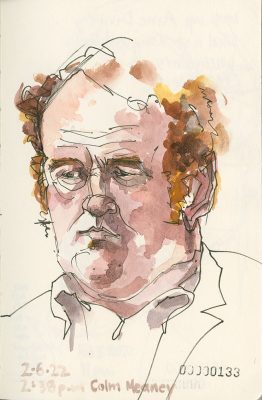
I go on and on about how much I love Hahnemühle’s Travel Journal. It’s about 8 x 6 inches and looks like a very thick Moleskine—i.e., black cover, elastic closure, back envelope, ribbon book mark. (Let’s just point out that the first thing I do when I open a new one is pull that ribbon book mark out and cut it off. I don’t have any need for it. I also wrap the elastic closure around the back cover, because I don’t use it either, but cutting it off would leave a void on the back cover, so I just leave it around the back cover and don’t use it.)
What I do use, and have used pretty much every day since I started using my first one about 5 years ago, is the book itself.
For reasons which deserve a post on its own I’m in “a-multiple-journals-at-one-time” phase. (I’ve run the gamut over my lifetime from a group of journals each dedicated to one specific thing, resulting in 20 simultaneous journals; to one journal for everything; to a few journals simultaneously (usually selected because of the media I was working with in the 4-week period it usually takes me to finish a journal). I’m currently in another “a few at a time” journals phase. I have a purse journal for out and about sketching and painting (which frankly is pretty much only the insides of doctor’s waiting rooms or supermarket parking lots currently). Then I have a lined notebook for painting and notes; a large sketchbook for anything including inserting photocopies of research that I haven’t yet melded into a project folder; and a box of 9 x 12 inch loose sheets of a variety of papers that is my “Loose Sheets Journal”; and always, always a Hahnemühle Travel Journal (HTJ).
I actually get quite nervous when I don’t have one of the last running all the time. I have never been that way in my life until the last five years. I’ve always just used one of the other journals that was in progress but not yet full. But I actually pine for another HTJ if I finish one and don’t have another to start immediately.

There are a lot of reasons I love this book. It’s a great size to carry in my purse or pack if I want. It contains drawing paper that is fun to write on if I want to take notes, do research, or ponder stuff. That same drawing paper has a little bit of tooth to it so it’s great for pencil, color pencil, and all the pens I love to use.
Yes, I freely admit that my beloved Staedtler Pigment Liners will bleed through this paper if you pause while you are drawing (and I’m one of those artists who tends to keep the tool on the page while pondering a direction change in line), but knowing that keeps me working faster and for me that’s not a bad thing.
Yes, I freely admit that my beloved DYE-based Pentel Brush Pens can bleed through the page when I add water and drag out shading from the ink lines. But I tend to scan those pieces right away, and the next page spread always seems to get filled with notes so no harm no foul right?
Yes, I freely admit that my beloved watercolors can bleed through the page if too much water is involved. BUT I’ve lived my whole young life painting on non-watercolor paper, and then spent my middle years painting on any type of paper that I wanted to use. So it shouldn’t come as a surprise to ANYONE that I want to paint on the paper I want to paint on and I will simply adjust my water amounts on the fly to suit the paper I’m working on. Actually that’s part of the fun of visual journaling for me. Why wouldn’t I love this paper then?
And there is a huge nostalgia value as it reminds me of the paper I used to use in sketchbooks and notebooks when I was a child and couldn’t afford expensive watercolor journals, and had not yet started binding my own journals with my favorite papers.
I mention all this to everyone who asks. And I do post about this book a lot, just check the blog’s search engine with a keyword search.
Because I’m clear on the pros and cons of this book and its paper I don’t feel even a twinge of guilt that I’m always letting people know how much fun I’m having with it. I’ve been very clear about how I use it.
If Hahnemühle keeps making it the way it is made now I expect that I will have one at my hand when I die. (In fact if I don’t that’s reason enough to consider my death might be suspicious.)
My whole point about reviewing art materials, papers, pens, etc. was to provide my students, and then since 2009, my blog readers, with information so they could make their art materials budget stretch farther. I want people to experience maximum joy with their art materials, not end up with a cabinet full of expensive materials they never use.
Also, in the course of this blog I’ve only accepted materials for review three or four times. And I’ve always stated when that happened. I haven’t accepted free materials because I wanted to give independent reviews.
Companies don’t fall over themselves asking me to review things because they’ve seen me point out problems in their product.
Most will realize if they look closely, however, that I am always clear about what I like and how it works for me and my painting and sketching style, and how the tool might work for someone with a different approach.
Another View Point
Almost exactly 2 years ago I sent a landscape HTJ to an artist friend of mine to test. (I’d ordered portrait journals, but the vendor had sent landscape journals and this artist liked landscapes.) His experience was not a happy one (when compared to mine). He wrote the following review in the next section of this post. And he sent a couple scans to me, knowing that I’d ask to share his views on this blog, as a tonic perhaps to my over exuberance about the HTJ.
Frankly I think everyone would be best served if they learned to bind books and then bound books with their favorite paper, whatever that happened to be. But I know not everyone enjoys binding as much as I do. And many (including me as I go through downsizing and come out the other end) don’t have the space for binding (at the rate that I did in the past 25 years).
I believe most people would be happiest getting a Strathmore 500 Series Mixed Media 7.75 x 9.75 inch SOFT BOUND journal and just call it a day. It will cover most of what they want to do and is a perfect size for pretty much everything; and especially for holding in your hand and sketching while standing.
I think our guest artist today agrees with me that the Strathmore 500 Series Mixed Media journal a good “universal” journal for artists in all media.
But everyone knows what I think about the HTJ so here are Paul’s thoughts. (Oh and he’s Canadian and his spelling reflects that.)
In a Note from Paul Savoie
I did a bit of testing in the Hahnemühle Travel Journal today (two scanned images attached).
Description from manufacturer: High Quality Sketch Paper, acid free, 140 gsm, 62 sheets, 13.5 x 21 cm (8.25 x 5.25 inches) landscape.
First Impression: Looks like it is solidly bound, thin hardcover, sewn, envelope inside back cover, ribbon marker, elastic closure, opens nice and flat. Paper is natural (off white) colour, nice smooth finish, decent paper weigh for “sketching”.
[Roz: I’d take exception to Paul’s description to the HTJ having a thin cover. It’s got cleanly wrapped stiff boards that hold up to a lot of pummeling in a back pack.]
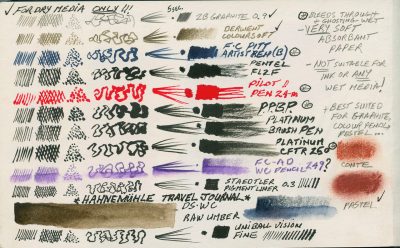
Paper Testing: Paper surface is a little smoother than Strathmore 500 MM, VERY soft ABSORBENT paper with little or no surface sizing? VERY easy to damage surface with wet media (light rubbing will pill paper surface), most of our favourite inks will badly feather on this paper (see in particular the fast to slow hatch lines with the Staedtler Pigment Liner (0.3) and Uniball Vision (fine) pens in the bottom right corner of the “dry media” test page).
Could be used for dry media like graphite, soft wax or oil based colour pencils, soft conté, soft pastels and watercolour pencils (dry, and with very “light” wetting). Heavy application of FC Pitt, PPBP, Platinum Carbon inks (and probably most dye based inks) will bleed through to the back side of page. Ghosting is visible on the back side of page with all inks and wet media.
[Roz: Anyone looking at most of my scans of pages from this book can see ghosted images of bold ink marks from the previous or next page. I don’t view this as a deal breaker as it happens on all lighter weight papers I use (and I use a lot of them) and it can be eliminated by scanning with black paper inserted behind the pages your scanning.]
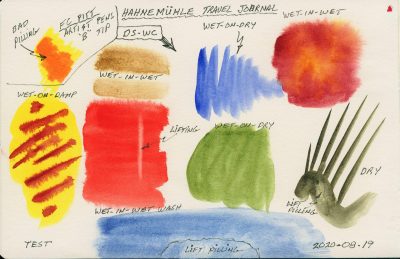
If you work lightly and fast with soft natural and synthetic brushes (no bristle brushes!) you can still have some fun with this paper. You will need to be confident with your marks as the paper just can’t stand anything but the very lightest of lifting or reworking. It’s not a forgiving paper at all. The paper will buckle slightly with wet applications but not objectionably so. Wet applications of watercolour paint will not bleed through but will show ghosting on the back side. Because it’s so absorbent you can get some great feathering and granulation effects, best done in a single pass and left alone (but isn’t that always the case :o).
[Roz: I think Paul and I have different understandings of “ghosting.” I don’t notice any ghosting (show through) of watercolor on the next page in my books. I do get some bleed through if I overwork an area or use too much water. You have to get in and out and not leave a puddle. If you do you’ll get pilling from fussing and bleed through from leaving puddles. But I will agree with everything else he said about using watercolor on this paper. It’s going to be a risky, high-wire act. Isn’t that fun?!]
Conclusion: Overall I can’t recommend this paper, very disappointing! There are lots of better papers out there. IMHO even the Stillman & Birn papers are better than this one!
[Roz: I don’t use any Stillman & Birn books/papers. I kept testing them for awhile when new papers would come out but I always have found them less responsive to anything I want to do than the other papers I enjoy using. And Paul doesn’t have any nostalgia bump like I do from the HTJ, which the S&B certainly doesn’t provide me. Again, if you’re looking for a really great, all-round, all media book, get the Strathmore 500 Series Mixed Media Journal with soft covers in the 7.75 x 9.75 inch size. It’s all you need. If you really, really want to do traditional watercolor paintings in your journal you can in the Strathmore 500 Series MM BUT you have to adjust some approaches and factors, but basically you have to anyway because we live in a world where the gelatin sizing which made up the ease of the great watercolor papers of history is now a thing of the past and ALL current watercolor journals using non-gelatin sized papers are going to require a bit of adjustment—whether you realize it or not because you haven’t painted on gelatin sized paper yet/ever. I haven’t found a journal with watercolor paper that is “perfect,” except for one made with TH Saunders/Waterford watercolor paper which I purchased from John Purcell. Hint: That paper was gelatin sized at the time—who knows what will happen going forward. Cheap Joe’s sells some wire bound journals made with TH Saunders/Waterford watercolor paper.
You can also read about other commercially bound watercolor journals here on my blog by using the search engine. Just know that if you’re entering the game at this point in the history of paper you’re looking for a unicorn. The question is, “what are you going to make do with?” I’ve given you one suggestion. A second is to bind pamphlet books with your favorite watercolor papers. (That’s not strenuous “real” binding, yet it is every bit as serviceable to an artist going out and about in the world with a journal.) And the third suggestion is to learn more about your process and how you use paint and water so that you can select a paper you’ll enjoy from what’s leftover.]
My Response to Paul’s Review on the HTJ
I wrote back to Paul, summarizing what I’ve written about in other blog posts about this paper. This is what I wrote:
Why do I love it? It’s a good size. I don’t normally like this Moleskine size, but for some reason this book feels good in my hand. And it is THICKER, which is a huge plus.
It is high quality sketch paper if you sketch with pencils. Hahnemühle seems locked in some sort of time warp thing where they only believe that people sketch with pencil?
Even though they make the best paper in the world for sketching in pen (Nostalgie) they still think people sketch only in pencil.
It is good for that.
Some people might also like it because it’s certified vegan. That doesn’t matter to me and sometimes it’s a negative.
While the paper is smooth I like it because it is also toothy, that to me means the fibers are quick to catch the medium I’m using.
It does have sizing. It is not sized for wet media—that’s what you’re getting with the Strathmore 500 Series Mixed Media journals.
Yep, it pills with wet media—this means you have to be quick, decisive, and low moisture in your approach.
Like this Make Some Marks.
and this: In Context—Painting on Drawing Paper.
and this: Finding an Art Buddy Might Be Detrimental to Your Drawing Practice
and this: My Friend Tom Won’t Stand Next to Me in an Electrical Storm…
And this: What Has Happened to Hercule Poirot?
That’s part of the fun. It’s just like trying to paint in the old Pentallic square drawing books that I used to use in the 1980s for journaling with color pencil (and being frustrated that I couldn’t use watercolor in them—but I’m cagier now!)
Also, in these pieces and some others that were done in color but not up on my blog, you have to pause and consider and take time and that’s great.
THE SAKURA PIGMA PROFESSIONAL BRUSH PEN feels great on these. Even when it starts to dry out as you can see here.
That pen has EXACTLY the right amount of drag on this paper!
(That’s also a good one because of the scrubbed on ink was in both images. SLOPPY or is it? Perhaps it’s intentionally messy in a way not possible on art papers?????)
Don’t even mention S&B in the same breath or paragraph with this book.
The HTJ is a book to bend to your will and have adventures with. Whereas for me the S&B is subpar more of the same…
Remember Hahnemühle isn’t telling you to do all the things I do on their paper. S&B is and their papers often don’t hold up.
You haven’t tested dye based inks and such, and even watercolors too wet—it will all bleed through the paper in the HTJ in bits. (Pentel’s pigmented squeezy brush doesn’t bleed through for me, but the dye ones do, and the PPBP does if held long in one place. And the Staedtler Pigment Liners do as well. If you pause them somewhere!)
DELIGHTFUL.
This is GRUNGE in action.
Best of all it reminds me of when I was younger and couldn’t afford expensive art journals with watercolor paper, and couldn’t even afford making them with that paper. So there is a wonderful nostalgia about working on this paper for me that totally hits my comfort and exhilaration zones at the same time. “Oh, this is so fun and familiar; oh, I can do this too!”
And at the same time, in world with less eye time to sketch and more time to write it’s wonderful for that as well. [This comment refers to my post-cataract surgeries reality.]
In the post above about the cakes of antiquities I write about how this book [the HTJ] saved my life last year while coming back from cataract surgery.
That’s not an exaggeration. It did.
And it has none of the weird smells coming off all the S&B papers!!!
You could have said worse things about it Paul (you left some things out! perhaps because you didn’t have time to test for them or because you don’t use them, etc.)
But the worst I can say about it is that I don’t have one on the go right now! My empty ones (portrait style ordered to replace the mis-mailed one I sent you in landscape) are in one of 7 boxes of commercially bound journals that went off to storage yesterday. (Yes 7 boxes. It made me sick to my stomach to see that, it also includes padded paper 9 x 12, and 11 x 14 inches. As I pulled it all together from different parts of the house I was reminded of the past 8 years when I’ve planned projects and gone to get the paper, and then some emergency would happen and we wouldn’t travel to Ireland, or… I’d be spending my time in the hospital with the folks, or trying to solve some computer disaster for the online teaching business.
And the paper and commercial journals just got shelved, “I’ll get back to that project later.”
But there is no “later.” There is only now. [I’ve always felt that but the operation results brought that home to me and] I turned to lined notebooks and the HTJ and it saved my life. Any drawing and painting I’m doing now is because of those sorts of books, my childhood, and my abso-fucking-lutely stubborn bent that refuses to give in at this point in the game.
So that’s what I think about this paper.
I guess I just wrote another blog post.
But I am sorry that you didn’t like it at all. I hope you can use it for note taking. Jake Shimabukuro is teaching Ukulele on Masterclass for instance!
(I have a populele but after I got it I had such problems with my finger tips cracking in the cold that I never tried to use it. But now, even Dick suggested that we go get a regular Ukulele…This of course is simple survival strategy on Dick’s part because he knows I need a project ASAP and that it can’t be a paper-based project, and it better engage my full mind. He’s willing to put up with me singing flat and my rhyming lyrics… “But I always loop them,” I called out as he left the room.)
Now I have written a post.
Got to run.
So There You Have It
So there you have it: two artists with pretty much the same assessment of the paper strengths and weaknesses, but with hugely different conclusions as to what the paper is good for, and opposed ideas as it whether it should even be used…
Isn’t life grand?
Learn YOUR PROCESS, understand how you use materials. Find papers that let you do your process with the materials you love.
If you get it right you’ll find that you won’t stop smiling as you work.
Find INDEPENDENT people who are reviewing materials and who specifically take into account how they use the materials, explain it, and include that context when explaining why they like or don’t like something. Teachers will have the added benefit of having watched students of all types work with a product. Being a teacher is one of the reasons I always formed my reviews with “if you work this way, or that way” statements, because I see what people are trying to do with the same materials right in class. Yes, you’re trying to teach them techniques, but if someone comes into your class with no practice or years of different practice behind them, they aren’t going to necessarily “get it” in one day—it will come to them over time with practice; the results of which I won’t see because they’ll have gone home by that time. All we can do as teachers is provide quality materials that we know will work in a certain way, explain that approach, give them some supervised practice, and then send them on their way. It leaves one with a desire to make sure students don’t spend their art budget money on fads.
Remember too, we live in a celebrity culture where “celebrities” review things for consideration—free supplies, sponsorship, promotion, and even renumeration. Their only human response is going to be to review something in a positive light so that they can continue that relationship with the manufacturer.
But will listening to their reviews actually help you find the right paper and materials? Only if they put things into context about how and why they like a given paper or tool. And you’re more likely to find that from an independent artist.
The Bottom Line
I’m going to keep using the HTJ as long as I live, as long as they keep making it in a way that gives me the same joy. (A change in the manufacture of the paper or cover will of course cause me to rethink and adjust.)
You may never use one. You may use one for note taking and not for any visual journaling. You may fill one book with pencil and color pencil work and never use one again.
But because I’ve been clear in MANY, MANY posts before this, and again in this post, about what the paper can do; and presented the findings of another artist who cares about paper almost as much as I do—you have a clear idea whether or not you need to keep on walking right by this journal, or give one a try.
Your goal right now, this very minute, needs to be a new commitment to your understanding of how you use materials and paper—a complete understanding of your process as it is today and where you want it to take you (as in what more you want to learn to meet your goals). This is a flexible state of understanding that will grow with you. (And it will also respond to changing market forces, such as the discontinuation of your favorite tool or paper, which will happen at least once in your lifetime. I’ve stopped counting in mine.)
If you take time to understand how you work and what you work with you’ll be able to navigate the retail art materials landscape with money still in your pocket.
And you’ll smile every time you work. You may even feel giddy. I’ve been known to hum.



















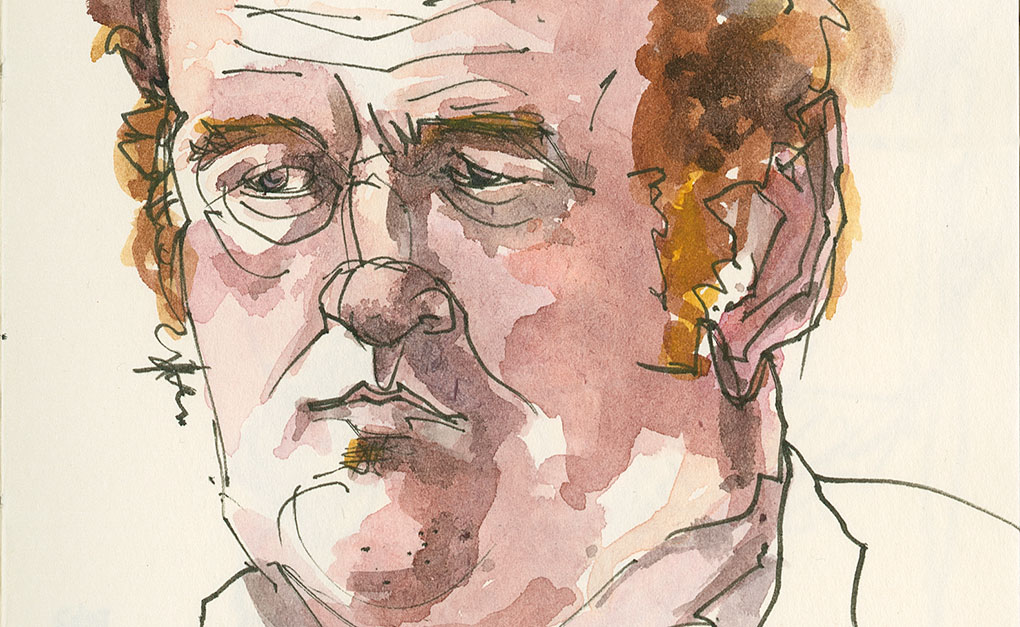
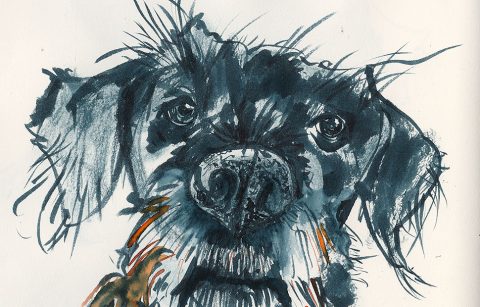
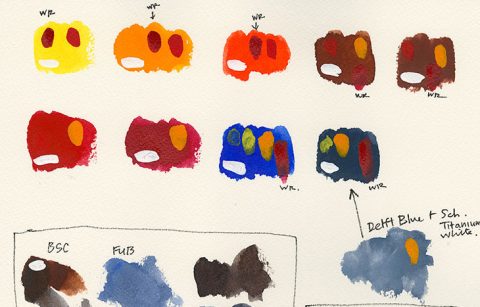
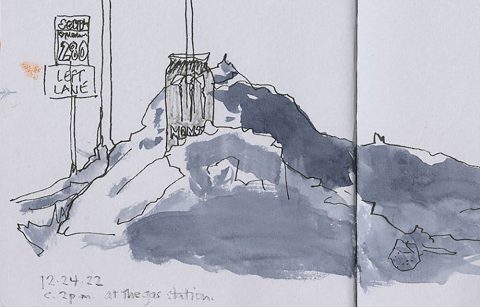
Thanks for the thorough reviews from two perspectives. Do you ever use the current Pentallic journals? I find that they perform well with ink and watercolor and are much cheaper than the Moleskines.
Mary, I don’t know the current Pentalic journals available. The drawing journals I used to use all the time from them were square, had drawing paper, a blue covering on the cover boards and a black fabric covering on the spine. They were definitely just for drawing materials. Or so I thought at the time. I had a couple extra on my shelf in the early 2000s and a friend who only used them came over one day to show me his work and I gave him what I had because you simply couldn’t get them any more.
Since then I have reviewed this Pentalic book https://rozwoundup.com/2014/09/pentalic-traveler-pocket-journalproduct-review.html
and also this Pentalic book https://rozwoundup.com/2010/12/pentalics-aqua-journal-landscape-format-watercolor-journal.html
The later is supposed to be a watercolor book. I don’t know if that’s the book that you’re referring to. I could only get it in landscape at the time (perhaps that has changed) and I don’t like landscape journals. I found the paper to be on part with student grade watercolor paper and there were better options (in Portrait or square orientation) out there in the market so I haven’t used another one. I found the $16.00+ cost at the time too expensive for what you get.
I think if one is only interested in student grade paper then the Hahnemühle watercolor journals that have the lower grade paper (not their cotton paper) are a great option.https://rozwoundup.com/2018/04/hahnemuhle-watercolor-sketchbook-review-part-3.html is part three of my review and you can use the navigation at the bottom of the post to go back to parts 1 and 2. I do not like their new 100 percent cotton watercolor journals. https://rozwoundup.com/2022/06/hahnemuhle-100-percent-cotton-watercolor-books.html
And because it’s been impossible to find good watercolor journals in sizes I like, I have over time become a fan of the Handbook watercolor journals that have 90 lb. and now 140 lb. watercolor paper. I like working on both of those. https://rozwoundup.com/2018/01/another-look-at-the-handbook-watercolor-journal.html
I don’t know what they sell for, but I quite like the 90 lb. paper book in square format and if people have the cost in their budget for art materials I think that’s a useful choice.
And I was a fan of the Paper in the Clairfontaine watercolor journals but they are difficult to find near me or online (last time I looked), confusingly labeled with by vendors, and the STRUCTURE FELL APART after what wasn’t very strenuous use as you’ll read in the post. Still I did enjoy that paper. And I know a number of friends working in watercolor who have totally shifted over to this book.
I don’t use Moleskine anything because they don’t make the watercolor large format they way they did years ago, and now ALL their paper options have a strong odor to them that I can’t be near for more than 30 seconds before I get a headache. (And I aired one book out for 2 years and it still retained the odor.)
Hope this gives you a clear view of my views on what’s out there. Thanks so much for stopping by.
Roz, a very interesting post. I was once guilty of a sketchbook fetish of sorts – I think I bought sketchbooks of every kind here in North America and in my travels in Europe and Asia. Even have some old ones with “Royal College of Art” stamped in gold on the black cover that I bought at the college in London thinking they would give my sketches more cachet (they are junk). That all ceased when I took your book binding course several years ago. I tried several different papers, but settled on the Strathmore Series 500 Multi-Media that could handle anything I wanted to do – ink (permanent, water soluble, sumi, ink brush – even the ones that bleed through regular paper), watercolor, acrylic, gouache, casein, graphite, and even pastel and charcoal with a fixative). I bound about two dozen sketchbooks with that paper (h x w: 5-1/2 x 5, 7 x 7-3/8, 10 x 12). I’ve never looked back since and I have enough to last the rest of my life (I’m 83) and if not I still have a couple of dozen full sheets of the paper, book board, and cover cloth to make several more. But I still enjoy reading your posts about things I will never try.
Thanks for stopping by Ted. I LOVE to hear that you have made all these Strathmore 500 Series Mixed Media journals for yourself. You’ve done exactly what I hope people will do, which is find something that works for the way they work and bind something to a size they find useful and then get to the business of sketching. I’ve never worried about you Ted because I know you “get it.” It makes me happy knowing you’re out there busy sketching.
Oops! It is Mixed Media paper instead of” Multi-Media” paper I said above (but which I will claim as a more accurate descriptor).
I understood what you meant!
Gee, Roz, I don’t think I’ve EVER read a post of yours in which your views and opinions weren’t absolutely clear. 😉 Thanks for your thorough assessments!
Thank you Tina!